Fitting shelves using brackets (2)
Long shelving
This article deals with fitting long shelves using brackets, for putting up short shelves, see this other article.
The method used to fit the brackets to the wall will vary and depend up on the construction of wall, walls will usually be:
- Brick or block covered in plaster,
- Brick or block dry lined with plasterboard,
or - Plasterboard or lathe and plaster on wooden studding (including timber frame),
Refer to our page for different fixings for different walls for details of fixing to the different wall types.
Positioning and fixing the brackets - first shelf.
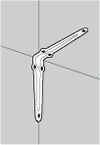 The overhang of each shelf beyond the end brackets should be kept equal and to a minimum, as a rough guide, no greater than 20% of the distance between brackets. (Our page on shelf materials gives guidelines for bracket spacing for different materials.)
The overhang of each shelf beyond the end brackets should be kept equal and to a minimum, as a rough guide, no greater than 20% of the distance between brackets. (Our page on shelf materials gives guidelines for bracket spacing for different materials.)
Hold the first bracket against the wall and establish the required height and horizontal position. Start with a bracket for the uppermost shelf when two or more shelves are being fitted.
Mark through the bracket vertical fixing holes on to the wall. Put the bracket to one side and drill the wall as appropriate and secure the bracket to the wall using the necessary screws/wall plugs etc.
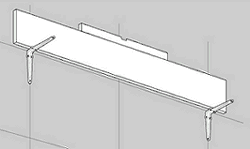 With the first bracket in place, hold up a second bracket for the other end of the shelf. Lay a straightedge (a shelf turned up on its edge is a good straightedge) across the top on the first bracket and onto the second bracket - put a spirit level on the top of the straight edge to establish the vertical position for the second bracket. Holding the second bracket in place, remove the straightedge
With the first bracket in place, hold up a second bracket for the other end of the shelf. Lay a straightedge (a shelf turned up on its edge is a good straightedge) across the top on the first bracket and onto the second bracket - put a spirit level on the top of the straight edge to establish the vertical position for the second bracket. Holding the second bracket in place, remove the straightedge
Mark through the bracket vertical fixing holes of the second bracket on to the wall. Put the bracket to one side and drill the wall as appropriate and secure the bracket to the wall using the necessary screws/wall plugs etc.
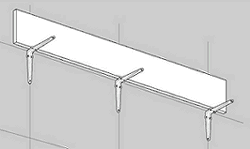 If further brackets need to be fitted between the end brackets, equally space them horizontally and use a straightedge resting across the top of the two end brackets to determine their height. Once the position of each intermediate bracket has been established, mark through the fixings holes onto the wall, drill the wall and secure the brackets in a similar manner as used for the end brackets.
If further brackets need to be fitted between the end brackets, equally space them horizontally and use a straightedge resting across the top of the two end brackets to determine their height. Once the position of each intermediate bracket has been established, mark through the fixings holes onto the wall, drill the wall and secure the brackets in a similar manner as used for the end brackets.
Leave fitting the shelf material to the brackets until all the brackets have been fixed to the wall.
Positioning and fixing the brackets - remaining shelves.
When further shelves are to be fitted below the first shelf, use the fixed brackets of the top shelf to set the horizontal position of the brackets for the lower shelves - drop a plumb-line (or use a straightedge and a spirit level) from the centre of the top brackets and mark the wall with a vertical line to give the horizontal position of the remaining brackets.
Establish the vertical position with the first bracket of each addition shelf and then line the other brackets up vertically using a straight edge across the top.
Fixing the shelf material to the brackets.
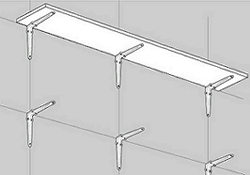 With all the brackets fixed to the wall, place the cut shelf material across the upper row of brackets and line it up horizontally so that the ends overhang the end brackets by an equal amount.
With all the brackets fixed to the wall, place the cut shelf material across the upper row of brackets and line it up horizontally so that the ends overhang the end brackets by an equal amount.
Fix the shelf material to the brackets using fixings which are short enough not to break through the upper surface. Start by putting one fixing in at one end bracket, then one at the other end bracket, then fit the remaining fixings - this will ensure that the shelving material won't move away from the wall.
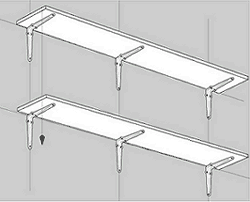 Repeat this procedure for fitting the remaining shelves but use a plumb line or straightedge from one end of the top shelf to establish the end position for the lower shelves.
Repeat this procedure for fitting the remaining shelves but use a plumb line or straightedge from one end of the top shelf to establish the end position for the lower shelves.
